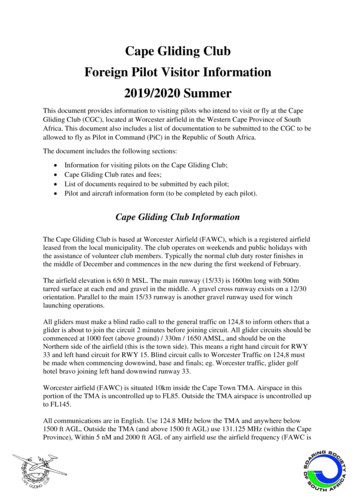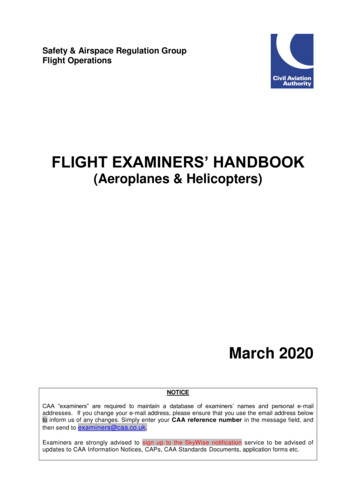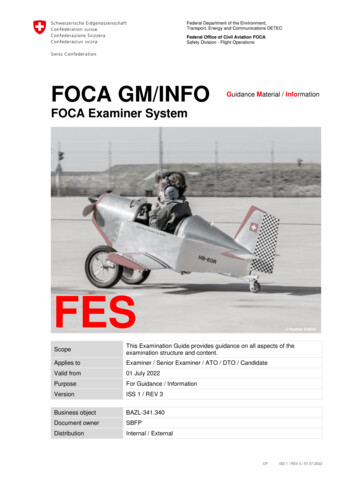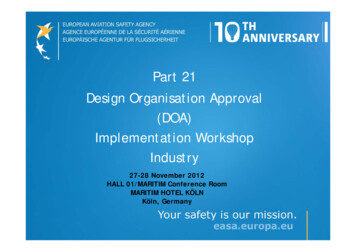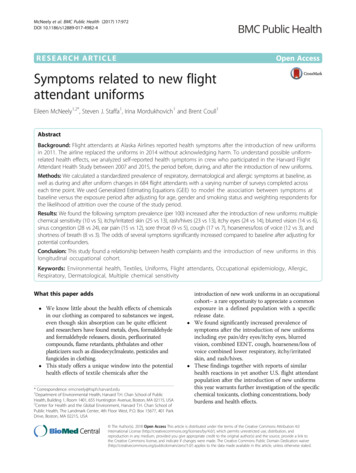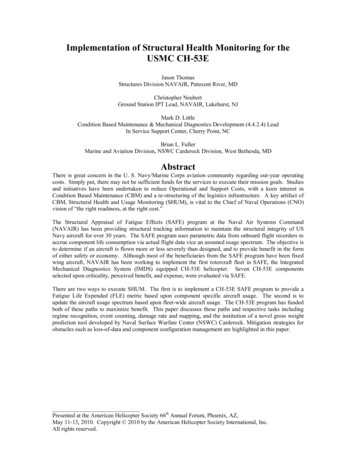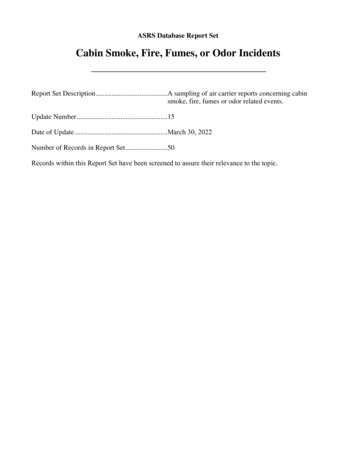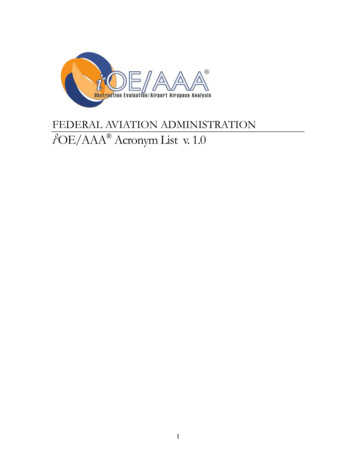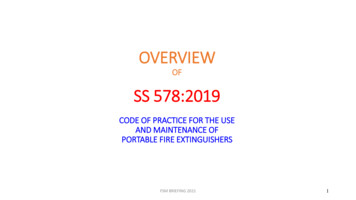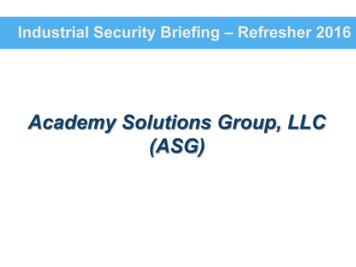
Transcription
Flight Operations Briefing NotesCabin OperationsCabin Decompression AwarenessFlight Operations Briefing NotesCabin OperationsCabin Decompression AwarenessIIntroductionAircraft have cabin air systems that control pressurization, airflow, air filtration, andtemperature. The purpose of these systems is to provide a safe and comfortable cabinenvironment, and to protect all cabin occupants from the physiological risks of highaltitudes. Modern aircraft are now operating at increasingly high altitudes.This increases the physiological risks that are associated with decompression.In the case of decompression, there is a risk that not enough oxygen will be supplied tothe body. This condition, hypoxia, is the greatest threat to both crewmembers andpassengers.A recently published accident report, involving a case of slow decompression,suggested that the overall aviation industry does not provide sufficient training to flightcrew and cabin crew on the identification and effective management of decompression.The objectives of this Flight Operations Briefing Note are, therefore, to: Review the different types of decompression Enhance cabin and flight crew awareness of the importance of rapidly takingappropriate actions to successfully manage decompression.Page 1 of 12
Flight Operations Briefing NotesIICabin OperationsCabin Decompression AwarenessTypes of DecompressionThe risk of a pressurized cabin is the potential for cabin decompression. This can occurdue to a pressurization system malfunction, or damage to the aircraft that causesa breach in the aircraft structure, enabling cabin air to escape outside the aircraft, forexample loss of a window, or a breach in the aircraft fuselage due to an explosion.The loss of pressurization can be slow - in case of a small air leak - while a rapid orexplosive decompression occurs suddenly, usually within a few seconds.The consequences of decompression, and its impact on cabin occupants, depend ona number of factors, including: The size of the cabin: The larger the cabin, the longer the decompression time The damage to the aircraft structure: The larger the opening, the fasterthe decompression time The pressure differential: The greater the pressure differential between the cabinpressure and the external environmental pressure, the more forcefulthe decompression.When cabin pressure decreases, cabin occupants are no longer protected fromthe dangers of high altitudes, and there is an increased risk of hypoxia, decompression,illness, and hypothermia. It is, therefore, important that crewmembers recognizethe different types of decompression, react effectively to overcome the difficultiesassociated with a loss in cabin pressure.II.1 Rapid/Explosive DecompressionRapid/Explosive decompression results in a sudden loss in cabin pressure, and can berecognized by the following signs: A loud bang, thump or clap that is the result of the sudden contact betweenthe internal and external masses of air Cloud of fog or mist in the cabin that is due to the drop in temperature, andthe change of humidity Rush of air, as the air exits the cabin A decrease in temperature, as the cabin temperature equalizes with the outside airtemperature The release of the cabin oxygen masks, when the cabin altitude reaches 14 000feet.Page 2 of 12
Flight Operations Briefing NotesCabin OperationsCabin Decompression AwarenessIf a breach in the aircraft structure is the cause of the decompression: Unsecured items in the immediate area are ejected from the aircraft Debris may fly around the cabin Loose items may become projectiles Dust particles may limit visibility.In the case of rapid/explosive decompression, there may be a lot of confusion due tothe high noise level and fog that makes it difficult to communicate in the cabin.II.2 Slow/Insidious DecompressionSlow/Insidious decompression involves a very gradual decrease in cabin pressure. Slowdecompression may be the result of a faulty door seal, a malfunction inthe pressurization system, or a cracked window.Slow decompression may not always be obvious. The cabin crew may not noticethe changes in the cabin, until the oxygen masks drop down from the PassengerService Units (PSUs). Therefore, the cabin crew must be aware of signs that couldindicate a slow decompression. In some cases an unusual noise, such as whistling orhissing sound around the door areas, may be an indication of a slow decompression,therefore the flight crew should be notified immediately.One of the first physiological indications of a slow decompression may be eardiscomfort or ‘popping’, joint pain, or stomach pain due to gas expansion.IIIHypoxiaAs mentioned, the greatest danger during decompression is hypoxia. To preventcrewmembers from becoming significantly impaired or incapacitated, the cabin crewmust continuously observe passengers and crewmembers for the signs and symptomsof hypoxia. The effects of hypoxia (lack of oxygen) cannot be over emphasized.It is important for the cabin crew to realize that even mild hypoxia, though not fatal,can have fatal results. This is because hypoxia can significantly reducethe crewmembers ability to perform, and consequently lead to errors that may be fatal.The insidious nature of hypoxia causes a subtle decrease in individual performance,followed by incapacitation, the symptoms may not be identified until it is too late.The most common type of aviation hypoxia is "hypoxic hypoxia", that occurs due to lowpartial pressure of oxygen in the arterial blood. If oxygen is not used immediately inhypoxia cases, it is possible that occupants become incapacitated and loseconsciousness in a very short time.Page 3 of 12
Flight Operations Briefing NotesIII.1Cabin OperationsCabin Decompression AwarenessPhysiological and Psychological Effects of HypoxiaIt is importantthemselves andmay show signsnot be botheredthat cabin crewmembers be aware of the symptoms of hypoxia inin others. During a decompression incident, some of the passengersof hypoxia: Some may appear to be dizzy and laughing and some mayto put on their oxygen masks.It is necessary to remember that each person may not react in the same way, and thatthe symptoms of hypoxia may manifest themselves differently in each individual.Initial signs of hypoxia include: Stomach pain due to gas expansion Tingling sensation in the hands and feet Cyanosis (blue discoloration of the lips and fingernails) Increased rate of breathing Headache Nausea Light-headedness Dizziness Sweating Irritability Euphoria Ear discomfort.These symptoms become more pronounced with the lack of oxygen, for example: Impaired vision Impaired judgment Impaired motor skills (not able to coordinate body movements) Drowsiness Slurred speech Memory loss Difficulty to concentrate.Hypoxia can cause a false sense of well-being. It is possible for a person to be hypoxicand not be aware of their condition. Therefore, it is important that the cabin crewrecognizes the signs of hypoxia, and provides oxygen as soon as possible, in order toprevent a loss of consciousness. The affected passenger or crewmember usuallyrecovers a few minutes after receiving oxygen. However, they may not be aware ofhaving lost consciousness.Page 4 of 12
Flight Operations Briefing NotesCabin OperationsCabin Decompression AwarenessIII.2 Time of Useful ConsciousnessThe time of useful consciousness refers to the time available to individuals to performtheir tasks, after they have been deprived of oxygen, but are still aware of theirenvironment and capable of controlling their actions.It is important for the cabin crew to realize that the time of useful consciousness isdifferent for each individual, and depends on the: Altitude Individual’s state of health Amount of activity.The cabin crew must remember that, in cases of continued physical activity, the time ofuseful consciousness (Table 1) is significantly reduced.TIME OF USEFUL CONSCIOUSNESSAltitudeModerate ActivitySitting Quietly22 000 feet5 minutes10 minutes25 000 feet2 minutes3 minutes28 000 feet1 minute1.5 minutes30 000 feet45 seconds1.25 minutes35 000 feet30 seconds45 seconds40 000 feet18 seconds30 secondsCarlyle, 1963Table 1Time of Useful Consciousness Table at Various AltitudesNote:It is important to emphasize that this table is only a guideline, and provides averagevalues that can increase or decrease, depending on the skills needed to accomplisha task, on the individual’s health, and on the amount of activity. For example, the timeof useful consciousness for a cabin crewmember involved in moderate activity issignificantly less, compared to a passenger that is sitting quietly.Page 5 of 12
Flight Operations Briefing NotesCabin OperationsCabin Decompression AwarenessThe following are some other factors that can contribute to reducing the time of usefulconsciousness:IV Fatigue: A person who is physically or mentally fatigued will have an increased riskof hypoxia Physical effort: During physical activity, there is an increased need for oxygen,an increased risk of hypoxia and, as a result, a decrease in the amount of usefulconsciousness time Alcohol: Alcohol can significantly affect behavior, and can increase the risk ofhypoxia, in addition to aggravating some of the behavioral changes resulting fromhypoxia.Cabin Decompression ProcedureIn 1995, a study conducted by the Civil Aero Medical Institute (CAMI) in the UnitedStates, entitled “Flight Attendant Procedures in a Decompression”, revealed thataccident investigators, and safety inspectors reported that cabin crew did not followthe recommended procedures during decompression. This study resulted in a FlightStandards Information Bulletin (FSIB released by the FAA), that providesthe recommended procedures in a cabin decompression event.IV.1 Immediate ActionsIn the case of decompression the immediate use of oxygen is critical.the first actions to be performed by the cabin crew are: Immediately don the nearest oxygen mask Sit down fasten your seat belt, or grasp a fixed object Hold on.Therefore,If the cabin crew is not able to sit down or grasp a fixed object, they should wedgethemselves between passengers and ask passengers for assistance. For example, inone cabin decompression event, a cabin crewmember was saved from ejection out ofthe aircraft, because a passenger was holding on to the cabin crewmember's ankle.The priority of the cabin crew is to consider their personal safety.Incapacitated or injured cabin crewmembers will not be able to assist other cabincrewmembers and passenger during the post-decompression phase.VCabin - Cockpit CommunicationDuring any emergency, effective crew communication is critical to a successfuloutcome. Effective Crew Resource Management (CRM) involves cooperation andPage 6 of 12
Flight Operations Briefing NotesCabin OperationsCabin Decompression Awarenesscommunication between the flight and cabin crew. In many abnormal and emergencysituations, the cabin crew plays an important role in helping the flight crew to identifyand resolve developing problems.Many incident and accident reports have revealed that effective crew communication,between flight and cabin crew, can make the difference between an accident andan incident. It has also been revealed that ineffective communication between the flightand cabin crew has contributed to the severity of an accident.V.1 When in DoubtCabin crew are trained to anticipate the occurrence of specific actions during specificevents. In the case of decompression, for example, it would be quite reasonable forthe cabin crew to expect the flight crew to make an emergency descent. However,when the expected does not happen, how should the cabin crew react if the oxygenmasks deploy and the aircraft continues to climb?This type of scenario was stated in a recently published accident report involving a slowdecompression. In this accident, the aircraft continued to climb.Today, this type of scenario is rare. However it is important to consider how the cabincrew should react in this type of event.In this case, the cabin crewmember seated closest to the cockpit, should immediatelynotify the flight crew of the oxygen mask deployment, and also to confirm thatthe flight crew have donned their oxygen masks.This highlights the importance of crew communication. It is vital to the safety ofthe flight that open communication is maintained between the cabin crew and the flightcrew.When the expected does not happen, the cabin crew must take the initiative toseek and find an explanation.If the cabin crew suspects that the safety of the flight is at risk, or that there isany indication of an abnormal situation, the cabin crew must immediately notifythe flight crew.V.2 Crew Communication in a Noisy EnvironmentIn the case of rapid/explosive decompression, the level of noise will be very high.Therefore, this makes communication difficult between the flight crew and the cabincrew, and equally between the cabin crew and the passengers. Due to the fact thateffective communication is vital during any emergency, the cabin crew should use anyavailable form of communication.For example, in several accidents involvingrapid/explosive decompression, cabin and flight crews were forced to communicate viahand signals and gestures. Cabin crewmembers must, therefore, be prepared toimprovise and use their imagination!Page 7 of 12
Flight Operations Briefing NotesVICabin OperationsCabin Decompression AwarenessPost DecompressionAfter a decompression, when the aircraft reaches a safe altitude, the cabin crew canmove around the cabin, and should use the portable oxygen cylinders until they areconfident that they can breathe without support.When the emergency descent is completed, and a safe altitude is reached, the cabincrew should consider their oxygen requirements. Due to the physical activity atan increased altitude, the cabin crew may still be exposed to hypoxia. Oxygendeprivation can be insidious and the cabin crew may not be the best judges of theirown oxygen intake after decompression.After cabin decompression, the cabin crew should:VII Check on the flight crew, and be prepared to assist in the case of pilotincapacitation Check passengers for any injuries Check the cabin for any damage Provide first-aid and oxygen, as necessary Report the cabin status to the flight crew.Oxygen SystemsWhen the cabin altitude rises above 14 000 feet, the oxygen masks stored abovethe passenger seats, in the lavatories, galleys, and crew stations will deployautomatically. The flight crew may also manually deploy the oxygen mask system.Oxygen masks are stowed in groups and have a release pin, connected to a lanyard.Pulling one mask is sufficient to activate the oxygen flow for all the other masks ofthe same group.The following two types of oxygen are available on the aircraft: Chemical Gaseous.VII.1 Chemically-Generated Oxygen SystemAs soon as an oxygen mask is pulled down, and the release pin is removed,oxygen begins to flow to the mask. It is not possible to stop the flow of oxygen after ithas started.The chemical generator creates heat, and therefore results in a burning odor wheredust has gathered. This is normal, however, passengers may become concerned withthe smell of burning associated with the oxygen generators.Page 8 of 12
Flight Operations Briefing NotesCabin OperationsCabin Decompression AwarenessTherefore, the cabin crew should make a passenger announcement, when it is safe todo so, that there is a possibility of a smell of burning associated with the normaloperation of chemical oxygen generator systems.VII.2 Gaseous Oxygen SystemThe activation of the gaseous system depends on cabin altitude. On the other hand,chemically generated oxygen does not depend on the aircraft altitude.There are a number/A large amount/A specific amount of high-pressure oxygen bottlesthat supply gaseous oxygen to the cabin.This gaseous oxygen system does notgenerate a burning odor, because no heat is generated.VII.3 Portable Oxygen CylindersOxygen cylinders are located throughout the cabin. The number and location ofthe oxygen cylinders varies, depending on the aircraft cabin configuration.Zodiac AVOX SystemsFigure 1Portable Oxygen Cylinder AssemblyVIIIFactors Affecting Compliance with Operational StandardsThe analysis of in-service events has revealed that operating standards may not beeffective, or applicable, in the following situations: The cabin crew does not recognize the indications of slow decompression, andcontinues to perform their tasks in the cabin as usual The cabin crew does not have sufficient hypoxia information and trainingPage 9 of 12
Cabin OperationsFlight Operations Briefing NotesIXCabin Decompression Awareness There is a lack of cabin crew procedures, applicable to a loss in cabin pressure,oxygen mask deployment, and aircraft continuation of climb. Often, the proceduresdo not sufficiently emphasize the importance of immediately donning the nearestoxygen mask The cabin crew does not apply the procedures correctly. For example, oxygenmasks are removed during decompression, causing incapacitation There is a lack of communication between the cabin and flight crew. For example,the cabin crew does not notify the flight crew of oxygen mask deployment inthe cabin.Prevention StrategiesIt is important for flight and cabin crews to be able to identify the different types ofdecompression, and immediately react appropriately in order to ensure flight safety andlimit the risk of hypoxia. This can be achieved through appropriate training, including:X Enhanced edifferenttypesof Developing an increased awareness of the signs and symptoms of hypoxia,the effects of hypoxia on performance, and the importance of immediately usingoxygen Understanding the need for good communication, coordination and cooperation,between the flight crew and the cabin crew.Summary of Key Points Operators should stress in their procedures, initial and recurrent emergencytraining, that the first and immediate action for all crewmembers duringdecompression is to immediately don the nearest oxygen mask Operators should incorporate comprehensive guidance material and information onhypoxia in: Flight and cabin crew training manuals Flight and cabin crew initial and recurrent training courses.Operators should ensure that these courses emphasize the need for effectivecommunication, coordination, and cooperation between the flight crew andthe cabin crew.Page 10 of 12
Flight Operations Briefing NotesXICabin OperationsCabin Decompression AwarenessAssociated Flight Operations Briefing NotesThe following Flight Operations Briefing Note can be consulted for additional informationabout crew communication: XIIXIIIXIVCrew CommunicationRegulatory References FAA Flight Standards Information Bulletin for Air Transportation – Use of OxygenMask by Cabin Crew During Decompression - http://www.faa.gov/ FAA Advisory Circular – AC 61-107A - Operations of Aircraft at Altitudes Above25,000 feet MSL and/or Mach Numbers (Mmo) Greater than .75 http://www.airweb.faa.gov/ FAA Advisory Circular – AC 120-48 – Communication and Coordination betweenFlight Crewmembers and Flight Attendants - http://www.airweb.faa.gov/ United Kingdom CAA - Flight Operations Department Communication – FODCOM1/2003 - http://www.caa.co.ukAirbus References A320 Family, A330, A340 & A380 Cabin Crew Operations Manuals Getting to Grips with Cabin Safety (Brochure) Safety First (The Airbus Flight Safety Magazine) – Issue # 03 – December 2006 –Pages 30-35 - Hypoxia an Invisible Enemy – Cabin depressurization effects onhuman physiology.Additional Reading Materials Flight Safety Australia Magazine Article – Dizzying Heights - March–April 2004 - Flight Safety Australia Magazine Article – November 1999Note:These articles can be found on the Australian Civil Aviation Safety Authority website http://www.casa.gov.au/.Page 11 of 12
Flight Operations Briefing NotesCabin OperationsCabin Decompression AwarenessThis FOBN is part of a set of Flight Operations Briefing Notes that provide an overview of the applicable standards, flyingtechniques and best practices, operational and human factors, suggested company prevention strategies and personal linesof-defense related to major threats and hazards to flight operations safety.This FOBN is intended to enhance the reader's flight safety awareness but it shall not supersede the applicable regulationsand the Airbus or airline's operational documentation; should any deviation appear between this FOBN and the Airbus orairline’s AFM / (M)MEL / FCOM / QRH / FCTM / CCOM, the latter shall prevail at all times.In the interest of aviation safety, this FOBN may be reproduced in whole or in part - in all media - or translated; any use ofthis FOBN shall not modify its contents or alter an excerpt from its original context. Any commercial use is strictly excluded.All uses shall credit Airbus.Airbus shall have no liability or responsibility for the use of this FOBN, the correctness of the duplication, adaptation ortranslation and for the updating and revision of any duplicated version.Airbus Customer ServicesFlight Operations Support and Services1 Rond Point Maurice Bellonte - 31707 BLAGNAC CEDEX FRANCEFOBN Reference: FLT OPS – CAB OPS – SEQ 09 – REV 01 – APR. 2007Page 12 of 12
In 1995, a study conducted by the Civil Aero Medical Institute (CAMI) in the United States, entitled "Flight Attendant Procedures in a Decompression", revealed that accident investigators, and safety inspectors reported that cabin crew did not follow the recommended procedures during decompression. This study resulted in a Flight
